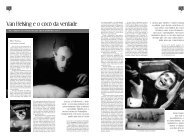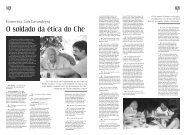Merleau-Ponty, 1964. Eye and mind. - Biolinguagem
Merleau-Ponty, 1964. Eye and mind. - Biolinguagem
Merleau-Ponty, 1964. Eye and mind. - Biolinguagem
- No tags were found...
Create successful ePaper yourself
Turn your PDF publications into a flip-book with our unique Google optimized e-Paper software.
to itself, homogeneous; its dimensions, for example, are by definition interchangeable.<br />
Like all classical ontologies, this one elevates certain properties of beings into a structure<br />
of Being, <strong>and</strong> in so doing it is both true <strong>and</strong> false. Reversing Leibniz's remark, we might<br />
say that it is true in what it denies <strong>and</strong> false in what it affirms. Descartes's space is true,<br />
when contrasted with a thought too empirically dominated, which dares not construct. It<br />
was necessary first to idealize space, to conceive of that being—perfect of its kind, clear,<br />
manageable, <strong>and</strong> homogeneous—which an unsituated thinking glides over without a<br />
vantage point of its own: a being which thought transcribes in its entirety onto three rightangled<br />
axes—so that subsequent thinkers could one day experience the limitations of<br />
that construction <strong>and</strong> underst<strong>and</strong> that space does not have precisely three dimensions,<br />
(as an animal has either four or two legs), <strong>and</strong> that dimensions are taken by different<br />
systems of measurement from a single dimensionality, a polymorphous Being, which<br />
justifies all of them without being fully expressed by any. Descartes was right in liberating<br />
space: his mistake was to erect it into a positive being, beyond all points of view, all<br />
latency <strong>and</strong> depth, devoid of any real thickness.<br />
He was also right in taking his inspiration from the perspectival techniques of the<br />
Renaissance; they encouraged painting to experiment freely with depth <strong>and</strong> the<br />
presentation of Being in general. These techniques were false only in that they presumed<br />
to bring an end to painting's quest <strong>and</strong> history, to found once <strong>and</strong> for all an exact <strong>and</strong><br />
infallible art of painting. As Panofsky has shown concerning the men of the Renaissance,<br />
this enthusiasm was not without bad faith. 26 The theoreticians tried to forget the spherical<br />
visual field of the ancients, their angular perspective which relates the apparent size not<br />
to distance but to the angle from which we see the object. They wanted to forget what<br />
they disdainfully called perspectiva naturalis, or communis, in favor of a perspectiva<br />
artificialis capable in principle of founding an exact construction. To accredit this myth,<br />
they went so far as to expurgate Euclid, omitting from their translations the eighth<br />
theorem, which was inconvenient. But the painters knew from experience that no<br />
technique of perspective is an exact solution <strong>and</strong> that there is no projection of the existing<br />
world which respects it in all aspects <strong>and</strong> deserves to become the fundamental law of<br />
painting. They knew that linear perspective was far from being an ultimate breakthrough;<br />
on the contrary, it opened several pathways for painting. For example, the Italians took<br />
the way of representing the object, but the Northern painters discovered <strong>and</strong> worked out<br />
the formal technique of Hochraum, Nahraum, <strong>and</strong> Schrägraum. Thus plane projection<br />
does not always stimulate our thought to rediscover the true form of things, as Descartes<br />
believed. Beyond a certain degree of deformation, it refers us back, on the contrary, to<br />
our own vantage point; as for the things, they flee into a remoteness out of reach of all<br />
thought. Something about space evades our attempts to survey it from above.<br />
The truth is that no means of expression, once mastered, resolves the problems of<br />
painting or transforms it into a technique. For no symbolic form ever functions as a<br />
stimulus. Symbolic form works <strong>and</strong> acts only in conjunction with the entire context of the<br />
work, <strong>and</strong> not at all by means of a trompe-l'oeil. The Stilmoment never dispenses with the<br />
Wermoment. 27 The language of painting is never "instituted by nature"; it must be made<br />
<strong>and</strong> remade. The perspective of the Renaissance is no infallible "gimmick." It is only one<br />
particular case, a date, a moment in a poetic information of the world which continues<br />
after it.<br />
Yet Descartes would not have been Descartes if he had thought to eliminate the enigma<br />
of vision. For him, there is no vision without thought: but it is not enough to think in order<br />
to see. Vision is a conditioned thought; it is born "as occasioned" by what happens in the<br />
body; it is "incited" to think by the body. It does not choose either to be or not to be or to<br />
think this thing or that. It must carry in its heart that heaviness, that dependence which<br />
10









